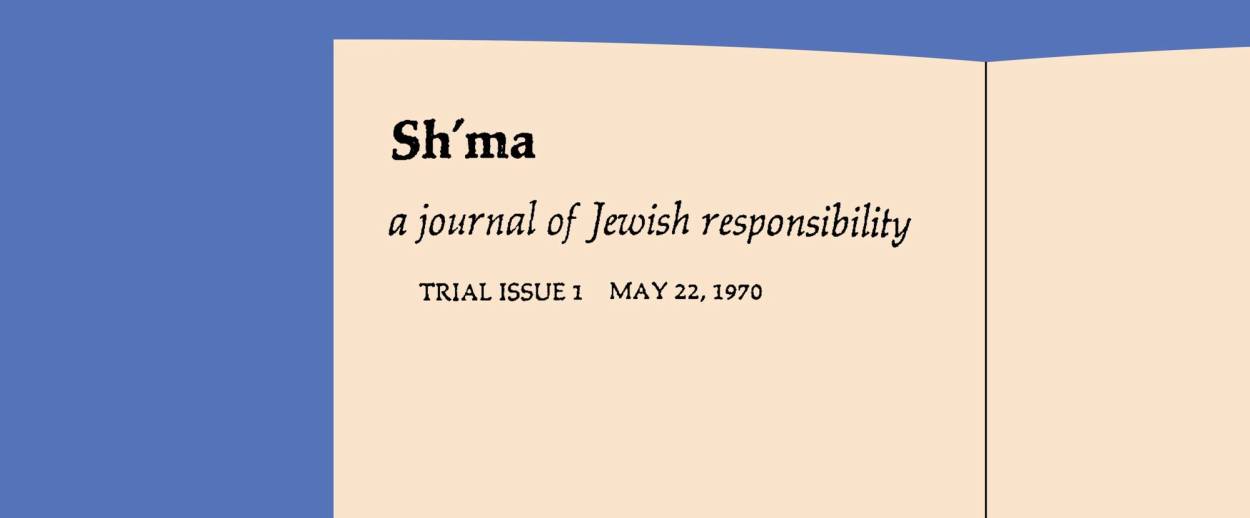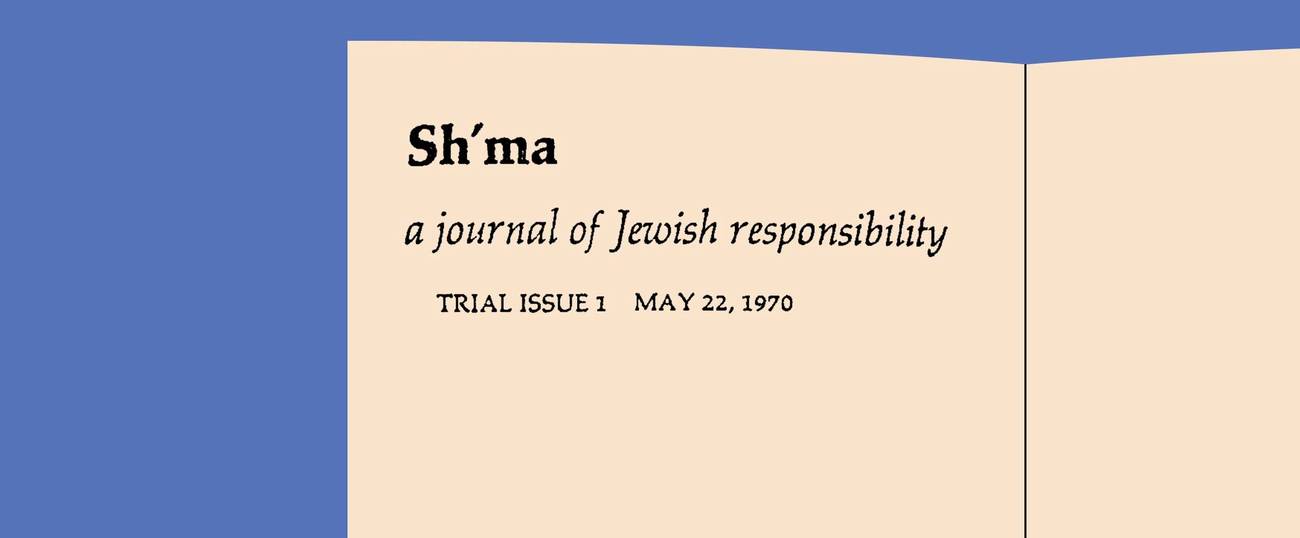The End of ‘Sh’ma’
The plucky Jewish magazine’s 50-year history leaves a wealth of stories worth revisiting




Last month’s news that the magazine Sh’ma would cease publication saddened me. However, that a magazine which for half a century had been a locus for open Jewish conversation and exploration would see its final issue in November also sent me on a momentary journey of nostalgia.
Founded in 1970 by the late Eugene B. Borowitz, professor of theology and education at the Hebrew Union College-Jewish Institute of Religion in New York City, Sh’ma lived for 50 years. Though the magazine passed through several iterations, for that half a century Sh’ma’s pages were always filled with diverse, often cutting-edge writing that gave voice to virtually every Jewish topic imaginable and reached into the heart of the American Jewish community. Whatever question filled the Jewish mind, Sh’ma would explore it. At its best, Sh’ma reflected upon the Jewish social, cultural, religious, intellectual, and political world against the backdrop of primarily the American scene.
My wave of nostalgia was brought on by the memory that for one academic year, 1981-82, my fourth year as a rabbinical student at Hebrew Union College-Jewish Institute of Religion, I served as Borowitz’s assistant editor on Sh’ma, helping to produce the 20 issues that came out biweekly between September and May. Borowitz would hire a student for this role, and for that year it was my privilege. One genuine perk of that privilege was the right to call him Gene. For everyone else it was Dr. Borowitz forever.
In those pre-internet days, Sh’ma was a funky operation; three part-timers—Gene, an assistant, and administrator Alicia Seeger—labored to produce the eight-page magazine for its 1,500 subscribers (if memory serves). Like all Sh’ma assistants, I got to install a dedicated phone at home for the year, making my living room a Sh’ma office. The magazine was produced on less than a shoestring; something in the neighborhood of $30,000 covered its annual expenses. The money was raised from paid subscriptions, an annual fund drive, and, likely, one or more angels who would make up the difference.
In the April 16, 1982, issue, a request for tzedakah stated: “As you surely know, Sh’ma provides a vital forum for discussion of Jewish ideas and affairs in a way no other Jewish journal does.” And so it was. Whether the topic was adoption, the first Lebanon war, Martin Heidegger, the ethics of amniocentesis, circumcision, the Shoah, alcoholism in the Jewish community, or an enormous raft of other topics, Sh’ma provided a space for open dialogue on these and so many more issues, maintaining a fierce commitment to pluralism that was then, and remains today, rare in the Jewish world. Sh’ma served as a Jewish town square in which all were welcome and all were respectfully heard. In my day, assisting in this effort was a who’s who of American Jewish intelligentsia, its contributing editors, including, inter alia, Elie Wiesel, David Novak, Blu Greenberg, Paula Hyman, Steven Schwarzschild, and Balfour Brickner. Their job was, essentially, to contribute a piece from time to time, be available to refer potential contributors, and lend their good names to a good cause.
Gene himself seemed to know everybody and everybody knew him. If we were looking for someone to write, Gene would say to me, “Call so and so,” and more than likely so and so would agree, or would at least have someone else we could invite. I was, prima-facie, amazed at the vastness of the body of contributors willing to write for no remuneration save some free copies of the issue. But one doesn’t need payment to contribute to the public square. Appearing in its pages was a privilege, sure, but also a contribution to the public good, perhaps even a duty. To be heard was both necessary and sufficient.
In 1993, Gene passed the torch to CLAL: The National Jewish Center for Learning and Leadership, during which time Nina Beth Cardin served as editor. In 1998, Yosef Abramowitz purchased Sh’ma for a dollar. For the rest of its life, over 20 years, Susan Berrin served as editor. In the last decade, the Lippman Kanfer Foundation for Living Torah became the major funder.
I took a tour of the Sh’ma archives, housed at the Berman Jewish Policy Archive, to get a sense of the breadth of Sh’ma’s prodigious output over the decades. I found an early piece (1972) by Eva Jospe arguing that Hermann Cohen remains an invaluable source of Jewish thought. An article by Stephanie Kolin (2014) explores the bifurcation of Jewish identity as symbolized by the mezuzah at our doors. There are ethical discussions, political roundtables, Gary Tobin arguing in favor of proactive conversion (1999), a Purim Torah about a diary by Spinoza showing he was a secret Sabbatean (in fairness that piece was mine—1982). In short, virtually any topic one might type into the search engine at the archives would yield results. Those 50 years in the Jewish public square generated a conversation from rabbis, scholars, thought leaders, and just plain folk. Gene used to say that every Jew had at least one Sh’ma article in his or her soul; all one had to do is help draw that piece out. All Sh’ma had to do was seek for or provoke the idea, and as if by magic (note: as if), an article from somewhere across the country would arrive and a new voice would speak.
Under Berrin’s term as editor, the magazine became a 24-page monthly, and Gene’s notion of pluralism underwent a change. Gene’s crowd, however broad that crowd might have been, was circumscribed by Gene’s own sensibilities, conditioned by his academic, intellectual-spiritual world of midcentury Jewish America. Berrin sought to broaden the notion of that totality by expanding the range of topics and writers, seeking to bring in voices from the periphery of the Jewish world. She always pressed for the maximum of accessibility, of opening Sh’ma up to the broadest community possible, both the insiders and the outliers.
One interesting example of a voice from the margins is an article on teshuvah, focusing on the biblical prophet Jonah, written from prison by Judith Clark (2012), a former member of the Weather Underground and the getaway driver in a Brink’s robbery in 1981 who was serving a 75-year-to-life sentence.
A regular feature of Sh’ma under Berrin was a page called Nishmah, let us listen, a play on sh’ma. Centered on this page would be a rabbinic quote. Surrounding it, Talmudic-fashion, would be four commentaries to the passage: a central interpretation and three reactions. The conversation on this page intended to enable the reader to participate in a piece of classic text by observing four different treatments of the passage and do so in a fashion that imitates a page of Talmud.
So Sh’ma changed with the times. The funky magazine of the original Borowitz years gave way to a glossier version. Where the original iteration was plain black and white, each issue under Berrin featured a piece of art and was filled with color.
Its budget increased substantially. The editor’s position became full time and along the way several positions were added. Its understanding of pluralism expanded to include voices beyond the movements and traditional organizational structures, while certainly maintaining those more traditional voices.
For the last 10 years of its life, Sh’ma received significant support from the Lippman Kanfer Foundation for Living Torah. Josh Rolnick, founding director of the foundation, in 2009 started the Sh’ma Institute; he was also president of the institute’s board. The reason for founding the institute was to assure Sh’ma’s independence.
Yet Sh’ma’s paid circulation never exceeded 3,000 and in recent years was in decline. The Sh’ma community struggled to identify the version that would work best in the digital era. They brought in a market analyst and other consultants, started a blog with about 25 regular writers. They struggled to understand who their ideal target audience should be. They tried to ascertain whether Sh’ma’s content provoked meaningful conversation. For a short time, Sh’ma entered into a partnership with The Forward, which included in it a four-page Sh’ma supplement.
The Lippman Kanfer Foundation for Living Torah attempted to find a partner to help them support Sh’ma. Though several institutions and individuals expressed some interest, in the end no one saw buoying Sh’ma as an essential cause, the funding world always being about making hard choices. So, in the end, the key stakeholders, with enormous reluctance, decided to cease funding the 50-year-old magazine.
Its passing leaves behind thousands of articles, a wealth of reaction by thoughtful men and women on the issues of the day well worth perusing both as a history of ideas, and for the edification it can yet provide the curious. Where once it had three part-time employees, it grew and then contracted. Under Gene Borowitz it was known as “a journal of Jewish responsibility.” Later it became “a journal of Jewish ideas.” In its final years it was called Sh’ma Now: A Journal of Jewish Sensibilities. However pluralism was understood, this plucky magazine was an open source for conversation that now, in its absence, is going to be difficult to find.
***
Like this article? Sign up for our Daily Digest to get Tablet magazine’s new content in your inbox each morning.
Phil Cohen is the rabbi of Temple B’nai Israel in Albany, Georgia, and the author of Nick Bones Underground, due out in October.